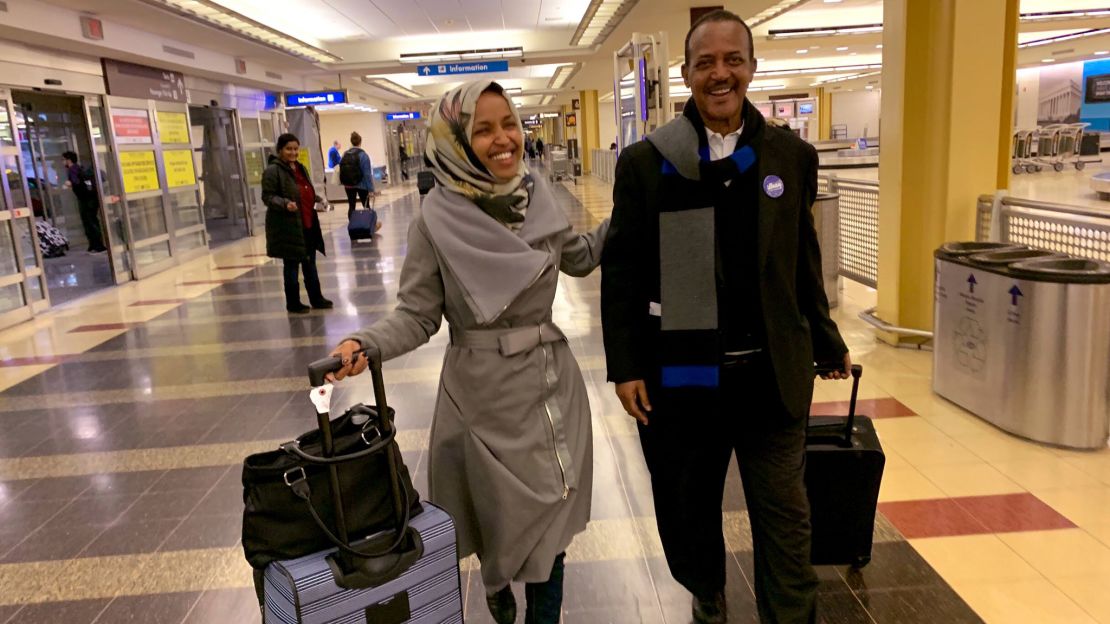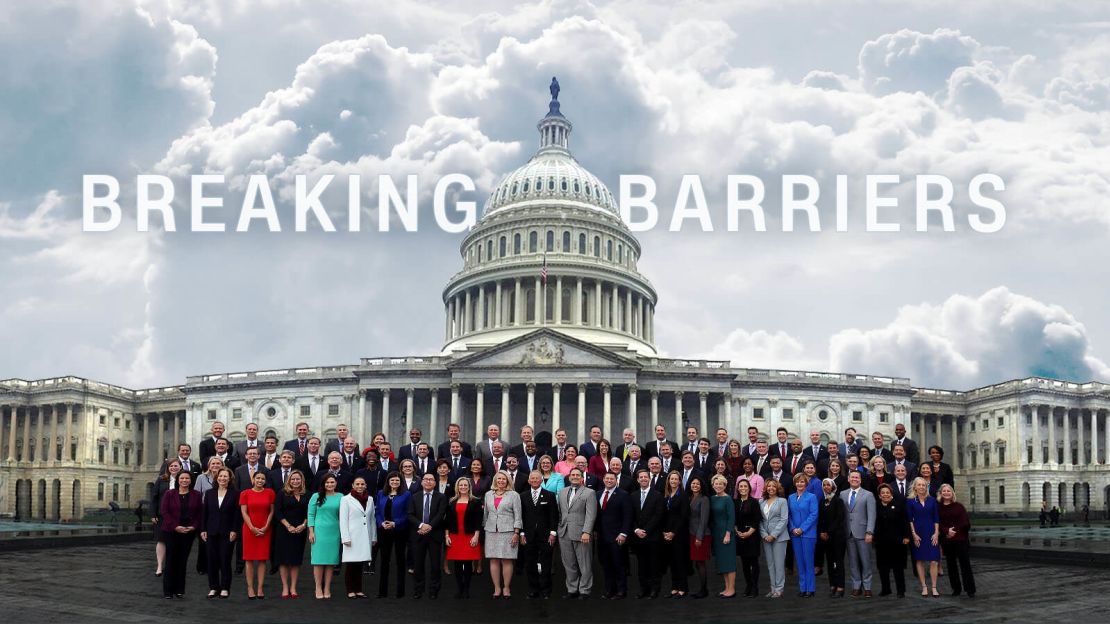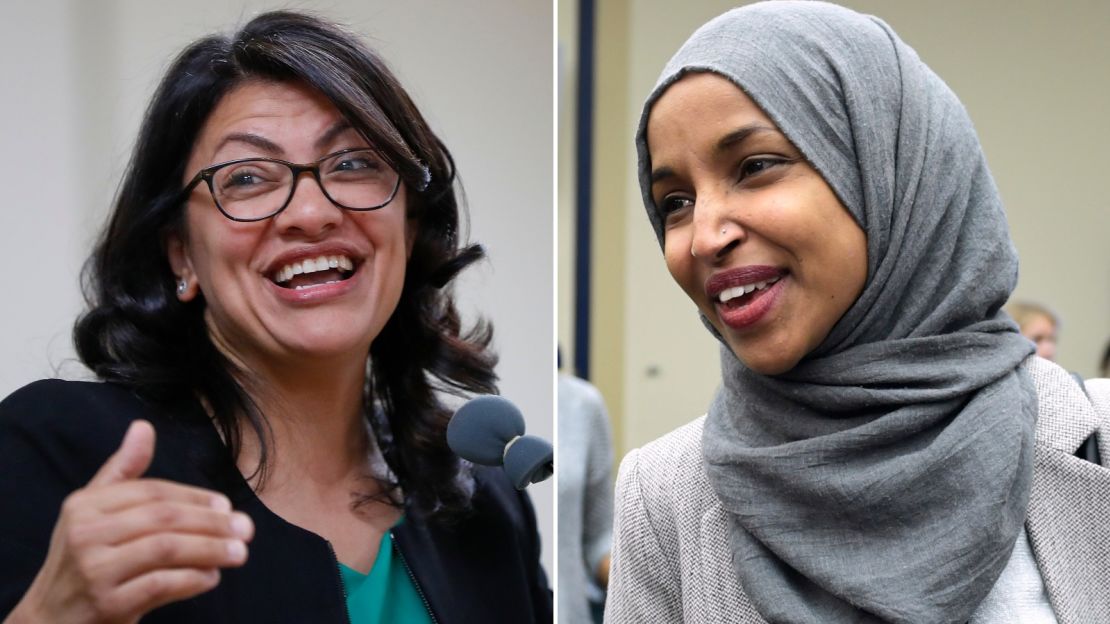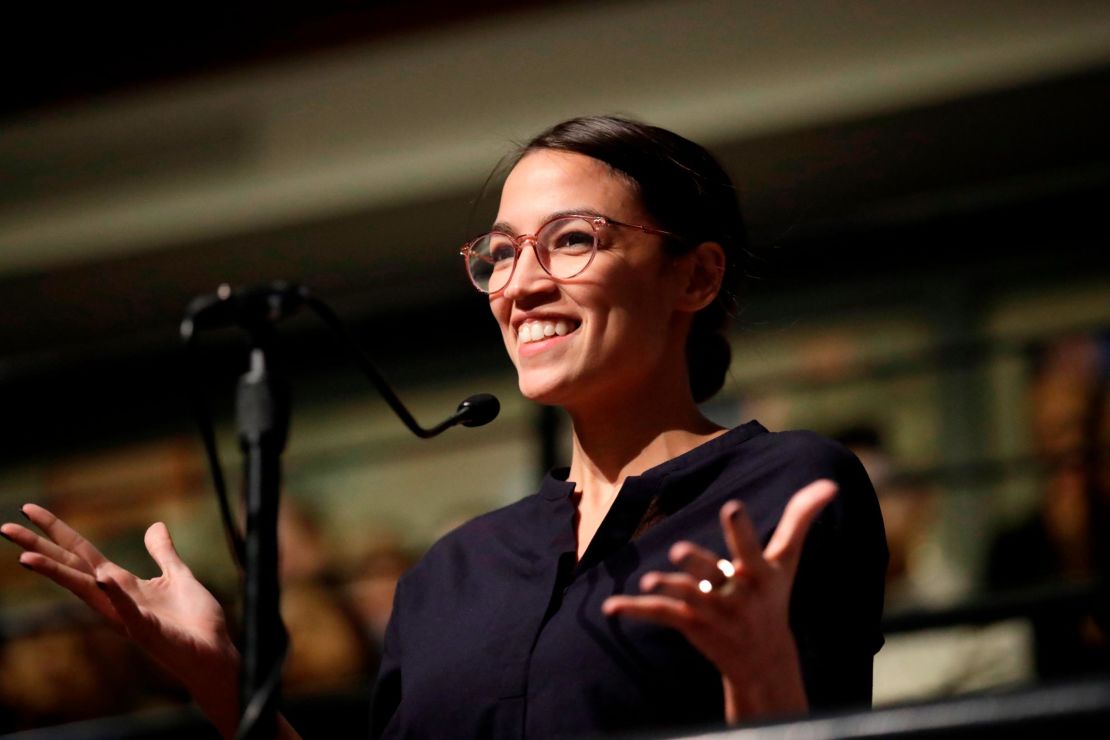The 116th class of Congress broke barriers before its members even set foot in Washington.
One example: Rep. Ilhan Omar, a Minnesota Democrat and the first Somali-American member of Congress, noted the history of her election on Twitter on Wednesday night.
“23 years ago, from a refugee camp in Kenya, my father and I arrived at an airport in Washington DC,” she tweeted, along with a photo of her and her father smiling with suitcases. “Today, we return to that same airport on the eve of my swearing in as the first Somali-American in Congress.”

Omar is just one of dozens of stories who started a new chapter Thursday. There were record numbers of women sworn in. Muslim women are serving for the first time – including Omar and Rep. Rashida Tlaib of Michigan – as are Native American women, including Reps. Sharice Davids and Deb Haaland. Texas sent the state’s first two Latina members to Congress, and two black congresswomen from New England also made history by coming to Washington. The historic firsts come from both parties and at least one member – Rep. Alexandria Ocasio Cortez of New York – is younger than 30.
Democrats seized control of the House on Thursday with fresh voices and new energy as they prepare to take on President Donald Trump, many of them inspired to run because of his presidency.
The new House majority will be led by a barrier breaker as well. Longtime Democratic leader Nancy Pelosi of California also made history on Thursday when she won back the speaker’s gavel and reclaimed a title she held from 2007 to 2011, when she served as the first, and still so far only, female House speaker. She spent Thursday afternoon taking pictures and participating in back-to-back ceremonial swearings-in of lawmakers with their families.

The party breakdown in the new House of Representatives is 235 Democrats and 199 Republicans, with one congressional race in North Carolina still unresolved. In the Senate, there are now 53 Republicans and 47 Democrats, a total that includes two independents who caucus with the Democrats.
The record number of women elected to Congress were key to Democrats reclaiming the majority in the House. Though Republicans, on the other hand, lost female representation.
Congress itself is changing to meet the new members coming to Capitol Hill. The new class also includes more women with young children, and female Congress members have recently been even more vocal in forcing the US legislative branch to catch up with the needs of members who are juggling child care and official duties. NPR reported Tuesday that the new Congress opened a new child care facility exclusively for employees of the House of Representatives.
The #MeToo movement is front and center as women take on new positions of leadership. Last month, Congress passed legislation to overhaul the way Capitol Hill addresses sexual harassment.

First Native American women in Congress
Kansas and New Mexico sent the first Native American women to Congress.
Democrats Sharice Davids of Kansas and Deb Haaland of New Mexico are the first Native American women elected to Congress.
Davids identifies as a lesbian, which will also make her the first openly LGBT member of Congress from Kansas.

First Muslim women in Congress
Incoming Democratic Reps. Rashida Tlaib of Michigan and Ilhan Omar of Minnesota are the first Muslim women elected to serve in Congress.
Omar also has the distinction of becoming the first Somali-American member of Congress. She came to the US more than two decades ago as a refugee.
Tlaib is the first Palestinian-American woman to be elected to Congress. The daughter of Palestinian immigrants, she became the first Muslim female member of Michigan’s state Legislature a decade ago.

Youngest woman ever elected to Congress
Incoming Democratic Rep. Alexandria Ocasio-Cortez of New York, who is 29 years old, will be the youngest woman ever in Congress.
Abby Finkenauer of Iowa, a 30-year-old Democrat elected to the US House, will also be one of the youngest members of Congress.
Other notable midterm ‘firsts’
Republican Marsha Blackburn has the distinction of being the first female senator from Tennessee.
Republican Cindy Hyde-Smith made history in the midterms by becoming the first woman elected to Congress from Mississippi.
Democrat Kyrsten Sinema became the first female senator elected to represent Arizona. Sinema will also make history as the first openly bisexual senator.
The state of Texas sent its first Latinas to Congress after Democrats Veronica Escobar and Sylvia Garcia won their congressional races to serve in the House of Representatives.
Incoming Democratic Rep. Ayanna Pressley is now the first black congresswoman to represent Massachusetts, while Democrat Jahana Hayes is the first black congresswoman from Connecticut.
Democrat Debbie Mucarsel-Powell of Florida became the first Ecuadorian-American, as well as the first South American immigrant, sworn into Congress.
New members will have to navigate a new political landscape
Newly elected members have been sharing their experiences on social media in a way we’ve never seen before.
There was Ocasio-Cortez using her Instagram stories to take people behind the scenes of the traditionally closed-door new-member orientation process, from office selection to learning the byzantine House tunnel complex, and using Instagram Lives to talk politics and take questions while making Instant Pot macaroni and cheese. There were fellow progressive newcomers, like Omar and Tlaib, never hesitating to use Twitter to fire back at critics (or traditional House floor rules) in a clear effort to announce the arrival of a new generation of politicos. There was incoming GOP Rep. Dan Crenshaw tweeting his New Year’s resolutions (including No. 5: get better at double ax throwing, with a video of said subpar double ax throw included, of course).
As newly elected members get used to Washington – hiring their staffs, figuring out their office budgets and figuring out which apartments to rent – they’ll also be faced with trying to navigate a new political landscape on both sides of the aisle.
For Republicans, most have aligned themselves with Trump.
Voices on the other side of the aisle are less united.
Progressive firebrands like Ocasio-Cortez, who promised to mobilize the resistance, have been elected to the same party as conservative and moderate Democrats who won in districts that went for Trump in 2016 – and they want to keep those seats in 2020.
On one side, progressives ran on promises of impeaching Trump, abolishing Immigration and Customs Enforcement, raising the minimum wage and “Medicare-for-all.”
Moderates, on the other hand, promised to prioritize small businesses, tweak the existing health care system, and work with Republicans and Trump when they can.
As the 2020 presidential election nears, and Democrats try to decide what kind of candidate they want to run, don’t expect these new voices to stay quiet.
This story has been updated to reflect additional developments.The 116th class of Congress broke barriers before its members even set foot in Washington.
One example: Rep. Ilhan Omar, a Minnesota Democrat and the first Somali-American member of Congress, noted the history of her election on Twitter on Wednesday night.
“23 years ago, from a refugee camp in Kenya, my father and I arrived at an airport in Washington DC,” she tweeted, along with a photo of her and her father smiling with suitcases. “Today, we return to that same airport on the eve of my swearing in as the first Somali-American in Congress.”

Omar is just one of dozens of stories who started a new chapter Thursday. There were record numbers of women sworn in. Muslim women are serving for the first time – including Omar and Rep. Rashida Tlaib of Michigan – as are Native American women, including Reps. Sharice Davids and Deb Haaland. Texas sent the state’s first two Latina members to Congress, and two black congresswomen from New England also made history by coming to Washington. The historic firsts come from both parties and at least one member – Rep. Alexandria Ocasio Cortez of New York – is younger than 30.
Democrats seized control of the House on Thursday with fresh voices and new energy as they prepare to take on President Donald Trump, many of them inspired to run because of his presidency.
The new House majority will be led by a barrier breaker as well. Longtime Democratic leader Nancy Pelosi of California also made history on Thursday when she won back the speaker’s gavel and reclaimed a title she held from 2007 to 2011, when she served as the first, and still so far only, female House speaker. She spent Thursday afternoon taking pictures and participating in back-to-back ceremonial swearings-in of lawmakers with their families.

The party breakdown in the new House of Representatives is 235 Democrats and 199 Republicans, with one congressional race in North Carolina still unresolved. In the Senate, there are now 53 Republicans and 47 Democrats, a total that includes two independents who caucus with the Democrats.
The record number of women elected to Congress were key to Democrats reclaiming the majority in the House. Though Republicans, on the other hand, lost female representation.
Congress itself is changing to meet the new members coming to Capitol Hill. The new class also includes more women with young children, and female Congress members have recently been even more vocal in forcing the US legislative branch to catch up with the needs of members who are juggling child care and official duties. NPR reported Tuesday that the new Congress opened a new child care facility exclusively for employees of the House of Representatives.
The #MeToo movement is front and center as women take on new positions of leadership. Last month, Congress passed legislation to overhaul the way Capitol Hill addresses sexual harassment.

First Native American women in Congress
Kansas and New Mexico sent the first Native American women to Congress.
Democrats Sharice Davids of Kansas and Deb Haaland of New Mexico are the first Native American women elected to Congress.
Davids identifies as a lesbian, which will also make her the first openly LGBT member of Congress from Kansas.

First Muslim women in Congress
Incoming Democratic Reps. Rashida Tlaib of Michigan and Ilhan Omar of Minnesota are the first Muslim women elected to serve in Congress.
Omar also has the distinction of becoming the first Somali-American member of Congress. She came to the US more than two decades ago as a refugee.
Tlaib is the first Palestinian-American woman to be elected to Congress. The daughter of Palestinian immigrants, she became the first Muslim female member of Michigan’s state Legislature a decade ago.

Youngest woman ever elected to Congress
Incoming Democratic Rep. Alexandria Ocasio-Cortez of New York, who is 29 years old, will be the youngest woman ever in Congress.
Abby Finkenauer of Iowa, a 30-year-old Democrat elected to the US House, will also be one of the youngest members of Congress.
Other notable midterm ‘firsts’
Republican Marsha Blackburn has the distinction of being the first female senator from Tennessee.
Republican Cindy Hyde-Smith made history in the midterms by becoming the first woman elected to Congress from Mississippi.
Democrat Kyrsten Sinema became the first female senator elected to represent Arizona. Sinema will also make history as the first openly bisexual senator.
The state of Texas sent its first Latinas to Congress after Democrats Veronica Escobar and Sylvia Garcia won their congressional races to serve in the House of Representatives.
Incoming Democratic Rep. Ayanna Pressley is now the first black congresswoman to represent Massachusetts, while Democrat Jahana Hayes is the first black congresswoman from Connecticut.
Democrat Debbie Mucarsel-Powell of Florida became the first Ecuadorian-American, as well as the first South American immigrant, sworn into Congress.
New members will have to navigate a new political landscape
Newly elected members have been sharing their experiences on social media in a way we’ve never seen before.
There was Ocasio-Cortez using her Instagram stories to take people behind the scenes of the traditionally closed-door new-member orientation process, from office selection to learning the byzantine House tunnel complex, and using Instagram Lives to talk politics and take questions while making Instant Pot macaroni and cheese. There were fellow progressive newcomers, like Omar and Tlaib, never hesitating to use Twitter to fire back at critics (or traditional House floor rules) in a clear effort to announce the arrival of a new generation of politicos. There was incoming GOP Rep. Dan Crenshaw tweeting his New Year’s resolutions (including No. 5: get better at double ax throwing, with a video of said subpar double ax throw included, of course).
As newly elected members get used to Washington – hiring their staffs, figuring out their office budgets and figuring out which apartments to rent – they’ll also be faced with trying to navigate a new political landscape on both sides of the aisle.
For Republicans, most have aligned themselves with Trump.
Voices on the other side of the aisle are less united.
Progressive firebrands like Ocasio-Cortez, who promised to mobilize the resistance, have been elected to the same party as conservative and moderate Democrats who won in districts that went for Trump in 2016 – and they want to keep those seats in 2020.
On one side, progressives ran on promises of impeaching Trump, abolishing Immigration and Customs Enforcement, raising the minimum wage and “Medicare-for-all.”
Moderates, on the other hand, promised to prioritize small businesses, tweak the existing health care system, and work with Republicans and Trump when they can.
As the 2020 presidential election nears, and Democrats try to decide what kind of candidate they want to run, don’t expect these new voices to stay quiet.
This story has been updated to reflect additional developments.
CNN’s Eli Watkins, Clint Alwahab and Heather Fulbright contributed to this report.



